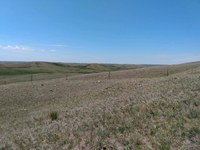Drought Creating Forage Shortage
(Click the image below to view a high-resolution image that can be downloaded)
The majority of livestock producers in North Dakota are faced with forage shortages due to drought.
Currently 99% of the state is experiencing some level of drought, with 18% and 49% categorized as being in exceptional (D4) and extreme (D3) drought, respectively.
“Unfortunately, the window for forage production is closing,” says Miranda Meehan, North Dakota State University Extension livestock environmental stewardship specialist. “In North Dakota, our grasslands are dominated by cool-season grasses. As a result, about 80% of forage growth occurs due to precipitation occurring between April 1 and June 30.”
Ranchers who have tame grass pastures or hay land should expect at least a 50% reduction in forage production. In the D4 areas, tame grass production will be 25% at best.
However, some producers may not have adequate production to justify haying. Once these grasses produce a seed head, the plant has limited potential to produce additional biomass. If the plants were grazed in the vegetative stage, the potential exists for regrowth if moisture occurred.
“Recent rains will benefit native rangeland because these species are in the vegetative stage,” says Kevin Sedivec, Extension rangeland management specialist. “Producers in much of the state should expect 50% to 60% of normal production on native pastures. In the D4 areas of the state, forage production on pasture will be 25% to 30% of normal at best.”
This reduction in forage production will shorten the grazing season, bringing it to a close sometime this summer instead of in the fall unless destocking of livestock occurs. To account for the deficit in forage production, producers will need to adjust their management plan to provide supplemental forage and/or reduce the forage requirements of their herd.
Annual forages can be a source of additional livestock feed if adequate moisture is available to support growth.
“At this point in the growing season, the best options for hay are warm-season grasses,” Sedivec says. “We recommend Siberian foxtail millet if available. If Siberian it is not available, use German foxtail millet. The next best option is sudangrass; however, sudangrass has an increased potential for prussic acid toxicity when drought stressed.
“If the intent is to establish an annual forage for grazing, we recommend planting a diverse cover crop mix that includes both cool-season and warm-season species,” he adds. “This will increase the chance of establishment and reduce the overall risk of a total failed crop. A diverse cover crop also will have the potential to produce a higher-quality forage with less risk of toxicity.”
The drought also has been stressful on crops, resulting in thin stands with potentially low yields. If crops are unharvestable, producers may have the opportunity to use them as hay or for grazing. However, producers need to be careful because drought-stressed crops can be toxic.
The most common toxicity is nitrates, which are common in small grains and corn. Failed crops should be tested for nitrates before feeding to livestock. For more information on nitrate toxicity, refer to NDSU Extension publication “Nitrate Poisoning of Livestock” (https://www.ag.ndsu.edu/publications/livestock/nitrate-poisoning-of-livestock).
“Given the severity of this drought, producers will likely need to combine these strategies while reducing stocking rates through culling and/or early weaning,” Meehan says. “Visit with your county Extension agent to develop strategies to reduce livestock forage demand.”
NDSU Agriculture Communication - June 15, 2021
Source: Miranda Meehan, 701-231-7683, miranda.meehan@ndsu.edu
Source: Kevin Sedivec, 701-424-3606, kevin.sedivec@ndsu.edu
Editor: Ellen Crawford, 701-231-5391, ellen.crawford@ndsu.edu


